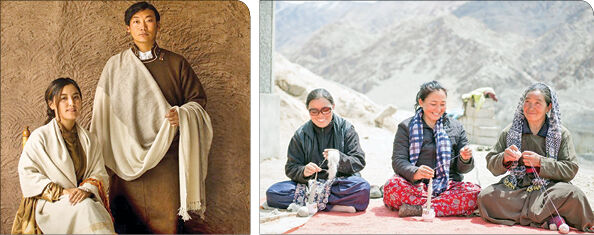Pashmina: The royal fabric
Pashmina is a combined outcome of largely unrewarded labour of Changpas who extract the wool from Changra goats, and the exquisite craft of Kashmiri artisans who have perfected several designs and motifs over centuries

Changthang plateau, the world's highest cold desert at a height of 15,000 feet in the Union Territory of Ladakh is home to the 5,000-member pastoralist community of Changpa who, for centuries, have lived close to nature in these high altitudes with their yak, camel and Changra goats. Changra is the rare goat breed that produces the world's finest and most expensive wool, Pashmina, 'as a cold-shielding undercoat' that is eight times finer than human hair.
However, even though Pashmina is the world's most expensive wool, the terms of trade are quite unfavourable to the Changpa community, as the weaving is done by the Kashmiris, and marketing by luxe brands which spend a fortune on models and product portfolios but leave the primary producer in the lurch, so much so that their number is fast declining – both on account of global warming which is adversely impacting the habitat of the Changra, as well as better opportunities in tourism and government jobs in Leh, the bustling headquarter city which is only 230 km away. In the last decade, the populations of Changra and sheep have declined by 30 per cent (at present, there are 2,00,000 Changras in Ladakh) and so have the herders. Another reason is restriction on grazing in the Chushul area along the Indo-Tibet border. This has affected nearly 100 families, each with Changra of an equal number.
However, after the creation of Ladakh as a UT, a sincere effort is being made to make Pashmina not just viable but also a preferred source of livelihood. In the first instance, Rs 245 crore has been sanctioned for "critical infrastructural development" in housing, health, education, and skill development to ensure that Changpa do not leave their traditional habitat and occupation. The administration is supporting the All Changthang Pashmina Growers Marketing Cooperative Society to cut out the middlemen and regulate the price of wool, indexing it to the global market. Even during the pandemic that saw a steep decline in the market for Pashmina, the society held consultations with the heads of all 25 Changpa villages to prevent distress selling of the fleece. Thanks to the corpus of Rs 300 crore from the administration, the society was able to assure a minimum support price of Rs 3,000/per kg for the basic raw material. However, the segregation of goat hair from the wool is done by the society — which has the only de-haring plant in Ladakh — after which the Pashmina is sold for Rs 11,000 a kilogram. The society shares the profit with the Changpa. The government is also working with the National Institute of Design and National Institute of Fashion Technology on design innovation. The long-term vision of the society is to establish a yarn bank to provide pure Pashmina yarn through the year and train more people in spinning and weaving Pashmina. Over 70 per cent of the Pashmina produced by the society is picked up by artisans of Kashmir.
The credit for pashmina being called "the royal fabric" certainly goes to the exquisite work of hundreds of Kashmir's highly skilled artisans. Mughal emperor Akbar was such an admirer of the shawls that he introduced the concept of dushala (double weaving so that both sides of the shawl can be used) and exported it to the Ottoman empire around the 16th century. The French general and emperor Napoleon Bonaparte was so enamoured by it that he gifted quite a few of those to his wife Josephine who then made it a style statement for the European royalty.
Over the last four centuries, the craftsmen of Kashmir have perfected several designs and motifs, of which the more prominent ones are described below. The first three are called Buti, Buta and Buta-Buti. While Buti is a small singular flower design which may or may not depict a root structure, the Buta motif is multi floral and a lot bigger than a Buti. The Buta-Buti lies in between: it is bigger than a Buti, yet smaller than a Buta and could include double, triple or quadruple flower heads. Then there is the Khat-rast — a striped pattern that runs throughout the length of the shawl. Sometimes it may incorporate the Buti in the stripes.
What is known throughout the world as the "Paisley" is called Badam/Ambi/Kairi by the weavers of Kashmir. The Lahariya motif is in zig- zag form and is usually used to depict water. Shikargah means hunting. This motif in shawls depicts jungle scenes with a lot of animal and human figures, and finally there is Zanjeer, literally meaning chains. This is a horizontal border design and encloses the main motifs, such as the Buta and Paisley.
Last, but not the least, we come to the GI tags for Pashmina. While The GI tag for Kashmir Pashmina relates to the shawls woven from Pashmina in the Kashmir region, Ladhak has applied for GI relating to the raw wool and fibre derived from the Changra goat. In addition to these, an application has also been filed for the Basohli Pashmina shawls woven in the Kathua and Doda districts of J&K.
Views expressed are personal



